Results 6,101 to 6,110 of 12096
Thread: Anandtech News
-
06-30-16, 01:32 PM #6101
Anandtech: ASUS Reveals Their New RX 480 GPU Design
After a lengthy tease from AMD we are finally seeing the new AMD Radeon RX 480 roll out. As we saw in our preview the card successfully makes leaps in its power to performance profile and brings a healthy performance jump to the mainstream market. It goes without saying that there will be custom cards coming from other vendors.
ASUS is the first to throw their hat into the ring with their new ROG Strix RX 480. This card will of course feature AMD’s new Polaris 10 core which brings us performance improvements with less power and heat. The ROG Strix RX 480 will also be an 8GB card running at 8GHz on the cards 256-bit bus, though ASUS has not yet released clock speeds for the GPU core.
The new card will be housed in ASUS’s DirectCU III cooler which will allow more performance and less noise. Around back the card will have a back plate. With both the back plate and the black metal shroud featuring Asus’s new Aura RGB lighting which will be helpful in color matching the card to a wide variety of builds.
ASUS is first to the punch with their custom cards, but many are sure to follow with the new release of the AMD Radeon RX 480. We’ll be sure to report on them as announcements come in.
More...
-
06-30-16, 02:50 PM #6102
Anandtech: Windows 10 Anniversary Update Launching August 2nd
While certainly not as big of an update as the original launch of Windows 10, the next major update now has a release date. August 2nd will be the date where all of the latest additions and features will be coming to Windows 10. The insider preview has been testing many of these for a while, providing feedback and bug reports to hopefully have a smooth launch.
There’s quite a few small changes coming, such changes to the Start Menu and lock screen, as well as new icons and locations for some of the settings to give it a better look and feel. Welcome changes will be things like being able to adjust music playback on the lock screen, as well as do some Cortana interaction without having to unlock the device.
One of the features that has been sorely lacking since launch though is extensions for the new browser, Edge. With the Anniversary Update, extensions will finally be available. There are a few extensions already in the preview builds, such as Adblock, Adblock Plus, Lastpass, Microsoft Translator, and a few more. The ability to use Lastpass is almost a make or break feature for me, so this is very much welcome. Extensions will be available through the store, and will be kept up to date through the store too.
First shown off at Build at the end of March, Microsoft is focusing even more on their pen support with Windows Ink. On a system with pen support, there will be an icon in the system tray to launch Windows Ink, where you can get quick access to pen-enabled apps, as well as discover more. They’ve added some excellent features for Windows Ink, including a digital ruler, and even the ability to set reminders by writing on notes. There seems to be a very vocal group that uses the inking quite a bit, and these changes should make that even more useful.
Windows Hello, which is the biometric authentication system which debuted with Windows 10, will also get some upgrades. Windows Hello support will be available in Microsoft Edge to allow Windows Hello login through the browser to supported sites and web apps. Hopefully this will be the first step on eliminating the password problem.
When this ships, Windows 10 will be about a year old, so it makes a lot of sense to start to deliver on some of the enterprise features promised when Windows 10 was first announced. The key one here is Windows Information Protection, formerly known as Enterprise Data Protection. This will help eliminate data leaks by securing devices, separating data, and preventing unauthorized users from opening the data. It’s a major feature for enterprises, and for those that want to read about it a bit more, they’ve posted a blog post about this update.
Gaming hasn’t been forgotten either, with Xbox Play Anywhere announced at E3, where you can buy a supported game once on either PC or Xbox, and play the same game with the same save files on either. There’s a lot more coming, and we’ll be looking into the changes further closer to the launch date.
Microsoft has also announced that the free upgrade offer would be ending at the end of July. If you were holding off upgrading but still wanted to, that date is quickly approaching.
Source: Microsoft
More...
-
07-01-16, 07:18 AM #6103
Anandtech: The Corsair Gaming K70 RGB RAPIDFIRE Mechanical Keyboard Review
There already are dozens of companies offering literally hundreds of mechanical keyboards, covering nearly all shapes and sizes. Designers try to innovate and differentiate but this becomes exceedingly difficult as the number of companies and products continue to increase while the number of the different mechanical key switches is small. Today we are having a look at the recently announced Corsair K70 RGB RAPIDFIRE and its Cherry MX RAPIDFIRE switches, a new type of switch developed for gaming and, for the time being, is exclusively available to Corsair.
More...
-
07-01-16, 05:00 PM #6104
Anandtech: ADATA Introduces Premier SP550 SSDs in M.2 Form-Factor
ADATA has introduced a new family of SSDs that come in M.2 form-factor and are more affordable than the majority of M.2 drives on the market. The Premier SP550 SSDs in M.2 form-factor utilize familiar architecture, a controller from Silicon Motion as well as TLC NAND flash memory. The most advanced M.2 Premier SP550, the 480 GB, has hit the street at $120.
The ADATA Premier SP550 is powered by the Silicon Motion SM2256 controller as well as TLC NAND flash memory produced by an unknown maker (though it's likely that the M.2 drives use chips from SK Hynix, just like the SP550 SSDs in 2.5” form-factor). The SM2256 controller supports error correction control and management technology based on low-density parity-check (LDPC) code to reduce data errors and increase data integrity. Besides, the SP550 drives use pseudo-SLC caching to ensure high writing performance as well as a dedicated DRAM cache.
The Premier SP550 SSDs are available in 120 GB, 240 GB and 480 GB configurations; they come in M.2-2280 form-factor and use the SATA 6 Gb/s interface, which means that performance of the new drives is in line with that of 2.5” SSDs based on the SMI SM2256 controller. ADATA claims that the new drives feature maximum read/write speeds of up to 560/510 MB/s as well as 4K random read at up to 75K IOPS. Exact performance specifications were not touched upon by ADATA, but they should be similar to comparable 2.5” models of the SP550.
ADATA released the original Premier SP550 SSDs in 2.5” form-factor in 2015. The drives were originally positioned as ultra low-cost solutions, and in our review we found that ADATA was able to hit a good balance between price and performance, offering solid performance for a low-cost SSD combined with very agressive pricing. Unsurpsingly then, they have been among the most affordable drives in the U.S. retail for quite some time now.ADATA Premier SP550 M.2 Specifications Capacity 120GB 240GB 480GB Controller Silicon Motion SM2256 NAND Flash SK Hynix 16nm TLC (?) Sequential Read 560MB/s 560MB/s 560MB/s Sequential Write 410MB/s 510MB/s 510MB/s Random Read IOPS 60k 75k 75k Random Write IOPS 70k 75k 75k TCG Opal Encryption No Power Management Slumber and DevSleep Warranty 3 years Current Retail Price $49.99 $79.99 $119.99
Finally, for retail pricing, ADATA has set the MSRPs of the M.2 Premier SP550 SSDs at $49.99 for 120 GB, $79.99 for 240 GB, and $119.99 for 480 GB version. This ends up being slightly higher than the 2.5” drives already on the market, though it's also fairly typical for M.2 drives as a whole.
More...
-
07-02-16, 04:30 AM #6105
Anandtech: AMD Releases Statement On Radeon RX 480 Power Consumption; More Details Tu
Following up on this week's Radeon RX 480 launch, there has been some questions raised about the power consumption of the card. This is after some sites whom directly tap the power rails feeding the card discovered that at least some of their samples were pulling more than the standard-allowed 75W over the PCIe slot and/or 6-pin PCIe external power connector.
To that end, it would appear that AMD's staff is working weekend duty, and they have just sent over the following statement.
As you know, we continuously tune our GPUs in order to maximize their performance within their given power envelopes and the speed of the memory interface, which in this case is an unprecedented 8Gbps for GDDR5. Recently, we identified select scenarios where the tuning of some RX 480 boards was not optimal. Fortunately, we can adjust the GPU's tuning via software in order to resolve this issue. We are already testing a driver that implements a fix, and we will provide an update to the community on our progress on Tuesday (July 5, 2016).If some of the data is to be believed, these cards are exceeding 150W total at times, which would mean there is either something causing them to run in the wrong power state, or they are just outright exeeding their power limit and need to be throttled back. As we don't do per-rail testing I don't have anything meaningful to add at this second, but it will be very interesting to see how AMD responds next week.
More...
-
07-05-16, 07:02 AM #6106
Anandtech: Evaluating the Toshiba OCZ RD400 M.2 NVMe SSD on a Skylake NUC
The Skylake NUCs have faced plenty of issues since their introduction late last year. However, stability has improved with the latest BIOS updates. One of the issues with the early BIOS versions was the M.2 SSD slot being effectively limited to PCIe 2.0 rates despite the chipset supporting PCIe 3.0. The latest BIOS version resolves this issue. We had carried a detailed evaluation of different M.2 SSDs for usage in the Skylake NUC. At that time, the Samsung SSD 950 PRO was the only option for providing maximum possible theoretical performance - a NVMe SSD with a PCIe 3.0 x4 link. Since then, Toshiba has also entered the fray with the Toshiba OCZ RD400. The RD400 has already been put through our rigorous SSD evaluation suite. In this review, we take a look at how the 512GB version fares in the NUC6i5SYK.
Introduction to the Toshiba OCZ RD400
The Toshiba OCZ RD400 is a PCIe 3.0 x4 NVMe SSD in the M.2 form factor. It can be purchased either in standalone M.2 2280 form factor, or with an add-in card. We have already discussed the RD400 hardware in detail. The important takeaway is that the controller is likely to be the Marvell 88SS1093, though we do not have direct confirmation of this aspect.
The 512GB version we evaluated is a single-sided card with two flash packages, a single DRAM package and the controller on board. These packages are covered by a sticker with the OCZ logo. In the Skylake NUC, the thermal strip attached to the lid is able to make contact with this sticker to aid in cooling down the components.
OCZ's site provides a special driver that improves performance compared to the standard Microsoft NVMe driver that ships with Windows 10. The SSD Utility software also gives an overview of the current state of the drive (including the currently active driver).
There are plenty of SSDs compatible with the Intel NUC6i5SYK, but, what does one choose for the best experience? There are decisions to make - PCIe 3.0 vs. PCIe 2.0, NVMe vs. AHCI, PCIe vs. SATA and so on. In this review, we are going to compare the Toshiba OCZ RD400 against four other M.2 SSD options:
- Toshiba OCZ RD400 512GB PCIe 3.0 x4 NVMe
- Samsung SM951 256GB PCIe 3.0 x4 NVMe
- Samsung 950 PRO 512GB PCIe 3.0 x4 NVMe
- Kingston HyperX Predator 240GB PCIe 2.0 x4 AHCI
- Mushkin Atlas Vital 250GB SATA 6Gbps
Buy Toshiba OCZ RD400 M.2 NVMe SSD on Amazon.com
The table below summarizes the specifications (claimed by the manufacturers) for the various evaluated SSDs. The entries in bold indicate the features corresponding to the tested sample.
Prior to looking at the evaluation methodology and core benchmark numbers, we first confirm that the RD400 can meet the claimed performance numbers in the Skylake NUC with the latest BIOS.M.2 2280 SSD Options - Specifications Drive Toshiba OCZ RD400 Toshiba OCZ RD400" ;Samsung SM951" ;Samsung SSD 950 PRO" ;Kingston HyperX Predator" ;Mushkin Atlas Vital" ; Available Capacities 128GB, 256GB, 512GB, 1TB 128GB, 256GB, 512GB, 1TB Interface PCIe 3.0 x4 PCIe 3.0 x4 Supported Protocols NVMe NVMe Evaluated Model RVD400-M22280-512G RVD400-M22280-512G Controller Toshiba TC58NCP070GSB Toshiba TC58NCP070GSB NAND Toshiba 15nm MLC Toshiba 15nm MLC DRAM 512MB 512MB Sequential Read 2600 MB/s 2600 MB/s Sequential Write 1600 MB/s 1600 MB/s 4KB Random Read 190K IOPS 190K IOPS 4KB Random Write 120K IOPS 120K IOPS Endurance 296 TBW 296 TBW Street Price (as on date) $310 $310 Warranty 5 years 5 years
CrystalDiskMark helps in that confirmation, and we see read bandwidth of more than 2600 MBps for high queue-depth scenarios.
Evaluation Methodology
Various PC benchmarks were processed on an Intel NUC6i5SYK (configured as specified in the table below) while keeping everything other than the M.2 SSD constant.
The various benchmarks presented in the next few sections were all processed with the M.2 SSD as the primary drive. The drive was initialized with two partitions. The primary OS partition was set to be 120GB in size, while the remaining space was allocated to the secondary partition. Both of the partitions were formatted in NTFS with default settings.Intel NUC6i5SYK Benchmarked Configuration Processor Intel Core i5-6260U
Skylake, 2C/4T, 1.8 GHz (Turbo to 2.9 GHz), 14nm, 4MB L2, 15W TDPMemory Corsair CMSX16GX4M2A2400C16 DDR4
15-15-15-35 @ 2133 MHz
2x8 GBGraphics Intel Iris Graphics 540 (Skylake-U GT3e) Disk Drive(s) Various M.2 SSDs Operating System Windows 10 Pro x64 Full Specifications Intel NUC6i5SYK Specifications
Our focus is on real-world benchmarks - SYSmark 2014, PCMark 8 Storage Bench and a slightly tweaked AnandTech DAS Suite. The DAS suite also helps in providing information about the power consumption and thermal characteristics.
SYSmark 2014
BAPCo's SYSmark 2014 is an objective performance benchmark for PCs. It is based on running real computer applications that one might use in day-to-day business / office activities. It is important to note that it does not intend to artificially drive components to peak capacity. Real user workloads and datasets are processed to determine how the user experience is impacted by the performance of the system.
SYSmark 2014 has three usage scenarios
- Office Productivity
- Media Creation
- Data/Financial Analysis.
The Office Productivity scenario models productivity usage including word processing, spreadsheet data manipulation, email creation/management and web browsing. The Media Creation scenario models using digital photos and digital video to create, preview, and render advertisements for a fictional businesses. The Data/Financial Analysis scenario creates, compresses, and decompresses data to review, evaluate and forecast business expenses. Also, the performance and viability of financial investments is analyzed using past and projected performance data.
The raw scores are meant to be compared against the 1000 scored by a Haswell Core i3-based desktop sporting a 500GB hard drive and 4GB of RAM. A score of 2000 would meant that the PC under test would appear to be twice as responsive as the calibration system.
SYSmark 2014's whitepaper (PDF) includes sensitivity analysis - how the scores vary with the amount of RAM, processor choice, GPU, storage drive, OS and display resolution. The whitepaper's sensitivity analysis for the storage subsystem involves comparison of a hard-drive based system and a SATA SSD. One can get as much as 20% improvement in scores (depending on the workload) by upgrading from a HDD to a SSD.
Since our evaluation also keeps all the system hardware and software the same, except for the storage drive, it also fits SYSmark 2014's sensitivity analysis model. It is expected that moving from a hard drive to a SSD provides huge performance benefits. It is likely that there is not much difference between different NVMe drives, and our results confirm the same.
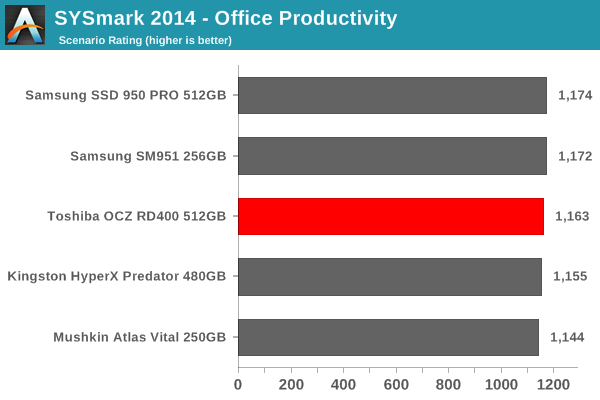
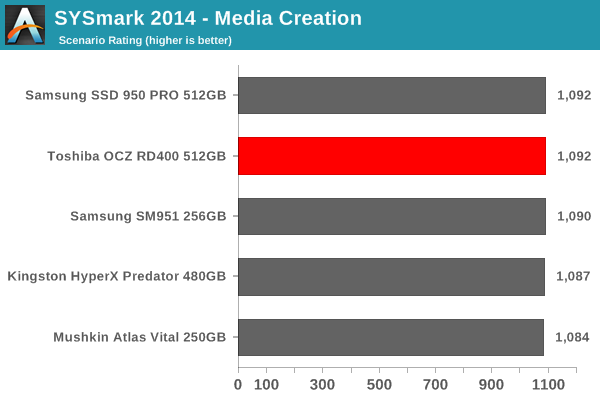

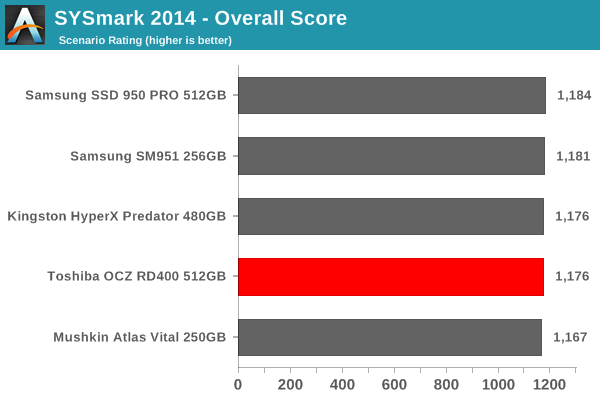
PCMark 8 Storage Bench
Futuremark's PCMark 8 evaluates the performance of PCs with a variety of benchmarks for different use-case scenarios. We usually present the scenario scores in all our system reviews. It is similar to the SYSmark 2014 scoring in terms of presenting overall effectiveness of the system for day-to-day activities. However, PCMark 8 also includes a dedicated storage benchmark suite.
The PCMark 8 Storage test simulates disk activity by playing back a trace of storage activity recorded during actual use of applications from the Adobe Creative Suite, Microsoft Office and a selection of popular games. Idle time compression is is avoided to make the benchmark behave more like real-world applications. The benchmark keeps track of the time taken to complete playback of the trace (termed as the primary result). The secondary result is the total amount of data transferred (both reads and writes) divided by the storage I/O busy time (i.e, time duration during which the number of pending I/O operations was at least 1). The secondary result is a very important metric when idle time compression is involved, but it doesn't matter as much as the primary result when it comes to application responsiveness (as the workload might be CPU-bound, rather than storage-bound).
PCMark 8's technical guide (PDF) explains the formulae used to arrive at the benchmark scores that are presented in the two graphs below.
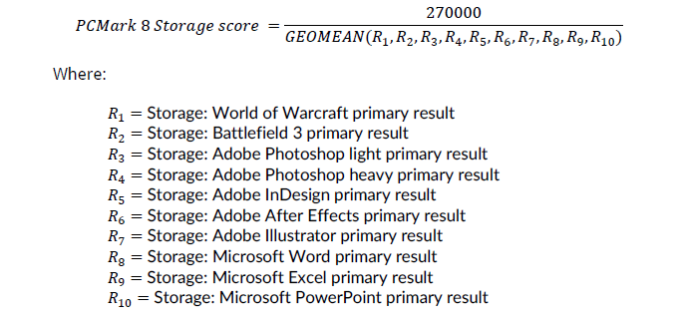

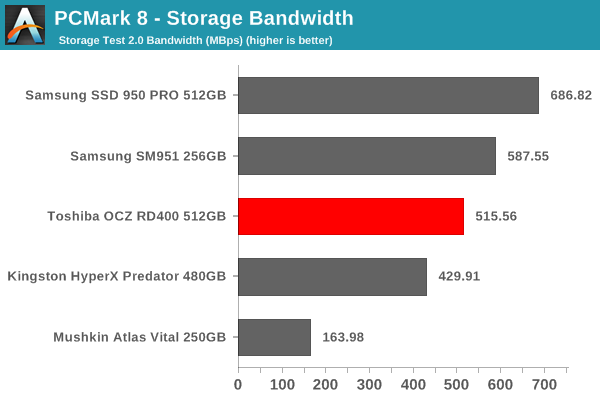
Thermal Characteristics and Power Consumption
SYSmark 2014 and PCMark 8 provide a high-level view of how the storage device might affect the overall responsiveness of the system. However, when evaluating different SSDs for use in the same system, there are other factors like power consumption and thermal characteristics. In addition, one of the scenarios not considered by either SYSmark 2014 or PCMark 8 is the transfer of large amounts of data (say, a bunch of photos or videos) from a mass storage device to the primary drive in the system. AnandTech's DAS (Direct-Attached Storage) Test Suite covers all these aspects.
The Intel NUC6i5SYK doesn't have a USB 3.1 Gen 2 or Thunderbolt port. Hence, it is difficult, if not, impossible, for an external storage device to keep up with the performance of the PCIe drives inside the system. Therefore, we modified our DAS suite to do the transfer from the primary 120GB partition to the secondary partition of the SSD under test. No RAM drive was set up. The bandwidth and temperature tracking were retained. The test can also reveal whether thermal throttling is triggered due to the transfer of large amounts of data (around 250GB) within a small time window. Before looking at the performance consistency / temperature / bandwidth graphs, let us take a look at the total instantaneous bandwidth numbers for the three different test cases in the DAS test suite.
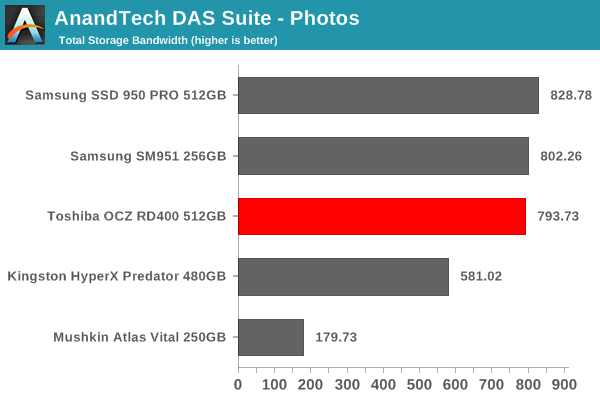
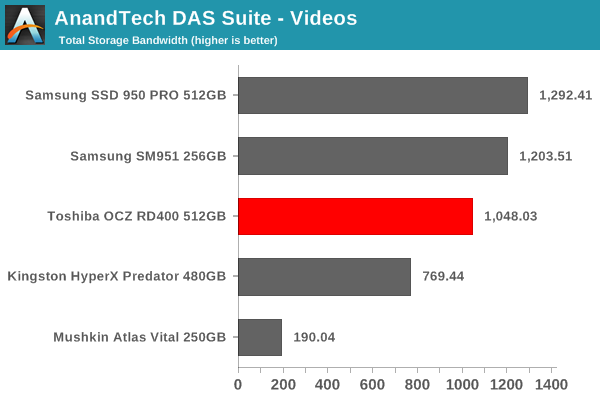

In terms of raw bandwidth and the time taken to finish copying large amounts of data between partitions, the PCIe 3.0 x4 NVMe SSDs (including the Toshiba OCZ RD400) obviously win big. However, one must also consider how common this use-case is going to be (given that most external storage devices for Skylake-U systems are not going to keep up with PCIe 2.0 x4 AHCI drives, let alone going to PCIe 3.0 x4 NVMe drives).
The graphs below show the temperature and instantaneous bandwidth numbers for the Toshiba OCZ RD400 while processing our DAS test suite. The temperatures are a bit of a concern, with the drive ending up at 68 C at the end of the benchmarking (transfer of more than 250GB of data within a 10 minute duration). Under the same conditions, the Samsung SSD 950 PRO topped out at 59 C.
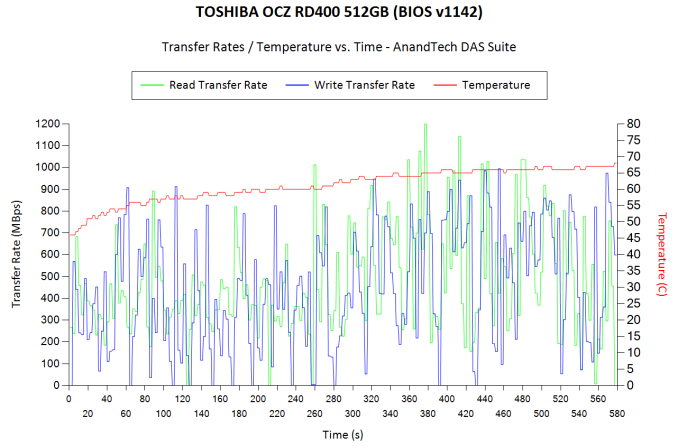
Power consumption numbers are in line with expectations. The NVMe drives end up making the system consume more power at both load and idle even though they get done with the storage queue faster. That said the OCZ RD400 has the least power consumption amongst all the evaluated NVMe drives.
Concluding Remarks
At the business end of the review, we can clearly see that the Toshiba OCZ RD400 M.2 NVMe SSD is a good choice for use in the Intel Skylake NUCs such as the NUC6i5SYK. The main concern is the thermal characteristics. For systems such as the Intel NUCs and the GIGABYTE BRIX units (with a thermal pad on top of the M.2 SSD), it is not a major concern. However, I would definitely not recommend it for units such as the upcoming ASRock Sylake NUC Beebox series which don't have the thermal protection for the M.2 SSDs.
Coming back to the Intel NUC6i5SYK and the Toshiba OCZ RD400 - despite providing higher peak performance compared to the Samsung SSD 950 PRO, workloads that demand consistency and low queue-depth performance (typical of workloads for which the Intel NUCs are suitable) end up making the SSD 950 PRO win the battle for the leading benchmark numbers. But, it must be stressed that these differences are hard to spot (for almost all users, even the Kingston HyperX Predator PCIe 2.0 x4 AHCI SSD will be equivalent to the NVMe SSDs in terms of perceived performance).
In the end, it all comes down to aspects such as pricing, warranty and specific requirements. The Toshiba OCZ RD400 is currently the only game in town for a 128GB or 1TB M.2 NVMe SSD. It also appears to have the best warranty terms (with the Advanced Warranty Program providing proactive replacement drives when necessary). The Toshiba OCZ RD400 is available either in solo M.2 form factor (suitable for the Intel NUCs and other similar SFF PCs) or a PCIe add-in card. The former has a current street price of $310, while the latter comes in at $330.
Buy Toshiba OCZ RD400 M.2 NVMe SSD on Amazon.com
More...
-
07-05-16, 07:56 AM #6107
Anandtech: The Samsung Galaxy S7 and S7 edge Review: Part 2
With part one of our Galaxy S7 review, it was clear that the Galaxy S7 was at least a mild improvement to the Galaxy S6 in some ways, but there were still many areas to investigate. At the time, we were in the middle of transitioning to our new 2016 benchmark suite, which meant that it was necessary to re-test the Galaxy S7.
Our 2016 benchmark suite attempts to really push our testing in general to a new level of depth and more importantly, more focused on the overall user experience. When reflecting upon the value of AnandTech from a testing perspective, it’s clear to me that while part of our value is running benchmarks across a wide range of phones, another part of our value is being able to run tests that others wouldn’t be able to run at all. To see how the Galaxy S7 performs in our new benchmark suite, read on for the full review.
More...
-
07-05-16, 11:10 AM #6108
Anandtech: GIGABYTE Announces GeForce GTX 1070 Mini ITX OC
As the various board partners finally begin unveiling their custom GTX 1000 series designs, GIGABYTE has arrived with their latest entry in the Mini ITX game. GIGABYTE’s GeForce GTX 1070 Mini ITX OC is a compact 17cm (7in) in length, allowing it to fit into Mini ITX gaming builds. The cooler on this card houses a 90mm fan with custom blades, which GIGABYTE claims will enhance the airflow. In the heatsink itself we can find three heat pipes which make direct contact with the GPU core. The aim of this cooler is of course to bring higher performance at lower temperatures. Though from my own experience good performance a less audible GPU fan behind the television is greatly appreciated as well.
The board itself is built out of higher quality materials in an effort to increase lifespan while giving improved performance. To go with the cooler and component choices, this card has been given a 5+1 phase power delivery system, as compared to the 4+1 phase system of the GTX 1070 reference PCB.
On the topic of overclocking this card comes with two performance profiles, Gaming and OC Mode. Gaming Mode is the default profile, which the slightly higher clocked OC Mode is enabled through their Xtreme Engine utility. Both the Gaming and OC Mode options offer a mild overclock over the founder’s edition card.GTX 1070 Specification Comparison GIGABYTE GeForce GTX 1070 Mini ITX OC (OC Mode) GIGABYTE GeForce GTX 1070 Mini ITX (Gaming Mode)GTX 1070
Founders EditionCore Clock 1556MHz 1531MHz 1506MHz Boost Clock 1746MHz 1721MHz 1683MHz Memory Clock 8Gbps GDDR5 8Gbps GDDR5 VRAM 8GB 8GB TDP 150W? 150W? 150W Launch Date ? 6/10/2016 Launch Price ? $449
As more Mini ITX cards come along it will indeed be interesting to see how powerful compact gaming rigs will become. Beginning with cards such as the AMD Radeon R9 Nano, enthusiasts in the last generation who wanted to save on space gained a lot of freedom on what they could do while maintaining big performance. This generation should improve performance in mITX systems by a good amount, and I don't expect this is the last mITX GTX 1070 we're going to see.
More...
-
07-06-16, 12:23 AM #6109
Anandtech: AMD's Tuesday Radeon RX 480 Status Update: New Driver By Late Thursday
Following up on this weekend's statement from AMD about a potential power issue with the reference Radeon RX 480, AMD has just sent over their previously promised update on their progress dealing with the issue.
In short, they are nearly finished preparing their updated driver, 16.7.1, which will be posted "within the next 48 hours" (which at this point is late Thursday). The new driver will offer two solutions to the power problem.
The default solution: shift some of the power load off of the PCIe Graphics (PEG) slot connector, presumably in order to bring power consumption within PCIe spec. Note that AMD doesn't say anything about reducing the total power consumption, and given option #2, it's reasonable to assume that this involves holding the power requirements as-is and shifting the load to the external 6-pin power connector. Based on earlier data this would potentially put the 6-in connector further over spec, but the vast majority of PSUs are very tolerant of this going out of spec.
The optional solution: a toggle that reduces the total power consumption of the card, presumably ensuring both the PEG slot and 6-pin power connector stay below their respective limits. Since the RX 480 is already throttling at times due to power limits, this would further hurt performance, but it's also the most standards-compliant solution (and aptly named "compatibility" mode). AMD notes that this option will have "minimal performance impact", and while we'll have to see the results in the benchmarks, it's worth noting that power consumption is exponential - roughly to the 3rd power of frequency - so a small reduction in frequency can significantly reduce power consumption, as we've seen in the case of the Radeon R9 Nano.
Along with this, AMD is also touting some slight performance optimizations in this driver that they hope will offset any performance loss (though I'd note that these optimizations would have come anyhow). We'll have more on this when AMD ships their driver.
In the meantime AMD's full statement is as follows:
We promised an update today (July 5, 2016) following concerns around the Radeon™ RX 480 drawing excess current from the PCIe bus. Although we are confident that the levels of reported power draws by the Radeon RX 480 do not pose a risk of damage to motherboards or other PC components based on expected usage, we are serious about addressing this topic and allaying outstanding concerns. Towards that end, we assembled a worldwide team this past weekend to investigate and develop a driver update to improve the power draw. We’re pleased to report that this driver—Radeon Software 16.7.1—is now undergoing final testing and will be released to the public in the next 48 hours.
In this driver we’ve implemented a change to address power distribution on the Radeon RX 480 – this change will lower current drawn from the PCIe bus.
Separately, we’ve also included an option to reduce total power with minimal performance impact. Users will find this as the “compatibility” UI toggle in the Global Settings menu of Radeon Settings. This toggle is “off” by default.
Finally, we’ve implemented a collection of performance improvements for the Polaris architecture that yield performance uplifts in popular game titles of up to 3%1. These optimizations are designed to improve the performance of the Radeon RX 480, and should substantially offset the performance impact for users who choose to activate the “compatibility” toggle.
AMD is committed to delivering high quality and high performance products, and we’ll continue to provide users with more control over their product’s performance and efficiency. We appreciate all the feedback so far, and we’ll continue to bring further performance and performance/W optimizations to the Radeon RX 480.
1: Based on data running ’Total War: Warhammer’, ultra settings, 1080p resolution. Radeon Software 16.6.2 74.2FPS vs Radeon Software 16.7.1 78.3FPS; Metro Last Light, very high settings, 1080p resolution, 80.9FPS vs 82.7 FPS. Witcher 3, Ultra settings, 1440p, 31.5FPS vs 32.5, Far Cry 4, ultra settings, 1440p, 54.65FPS vs 56.38FPS, 3DMark11 Extreme, 22.8 vs 23.7 System config: Core i7-5960X, 16GB DDR4-2666MHz, Gigabyte X99-UD4, Windows 10 64-bit. Performance figures are not average, may vary from run-to-run.
More...
-
07-06-16, 10:50 AM #6110
Anandtech: Western Digital Expands My Passport External USB 3.0 Drives To 4 TB
Western Digital last week introduced several new members to its My Passport family of external hard drives. The new portable external HDDs can store up to 4 TB of data, an improvement over previous-gen portable storage solutions from the company. The new drives are based on the WD’s new 2.5”/13.5 mm HDD platform which uses high-capacity platters.
Like the other Western Digital’s My Passport HDDs, the new models feature a USB 3.0 interface and come with automatic WD Backup software. The drives also have hardware AES-256 encryption. As for visual aesthetics, the design of the new 4 TB My Passport drives remained the same as that of the latest generation.
While the update looks fairly regular, it is important what is inside these new 4 TB drives. Western Digital traditionally does not disclose a lot of technical specifications of its external HDDs, such as spindle speeds or cache sizes. However, what the company did confirm is that the new My Passport 4 TB HDDs are based on 2.5”/13.5 mm hard drives featuring four 1 TB platters. We believe these should be based on either PMR or SMR technology. 2.5” SMR platters of such capacities are not something brand new in general because Seagate has been using them for several months but it would be noteworthy if Western Digital has started to use them for commercial products. Besides, the company has a platform that can house four of such platters, thus enabling 4 TB 2.5”/13.5 mm HDDs.
Western Digital stresses that it has not announced any internal 4 TB 2.5”/13.5 mm hard drives for consumer or other devices, which is perhaps not surprising given that mainstream notebooks use 7 mm and 9.5 mm drives. Nonetheless, formally Western Digital has the highest-capacity commercial 2.5”/13.5 mm HDD on the planet. Last year Seagate released its Samsung Spinpoint M10P HDD 4 TB HDD in 2.5"/15 mm form-factor, which has been exclusively used inside the Samsung M3 and P3 portable external hard drives.List of WD’s My Passport Drives with 4 TB Capacity Brand Model Interface Compatibility Color My Passport Ultra WDBBKD0040BBK USB
3.0/2.0Windows/Mac Black WDBBKD0040BBL Blue WDBBKD0040BWT White WDBBKD0040BBY Purple My Passport Ultra Metal WDBEZW0040BSL Silver WDBEZW0040BBA Blue My Passport for Mac WDBCGL0040BSL Silver/Black
Western Digital’s new My Passport Ultra 4 TB external HDD is already available from the company’s online store and from select retailers and distributors for $159.99. Next quarter the company plans to start selling its more expensive My Passport Ultra Metal and My Passport for Mac external HDDs with 4 TB capacity.
Gallery: Western Digital Expands Capacities of My Passport Drives Using 4 TB 2.5” HDD




_thumb.jpg)
More...
Thread Information
Users Browsing this Thread
There are currently 48 users browsing this thread. (0 members and 48 guests)




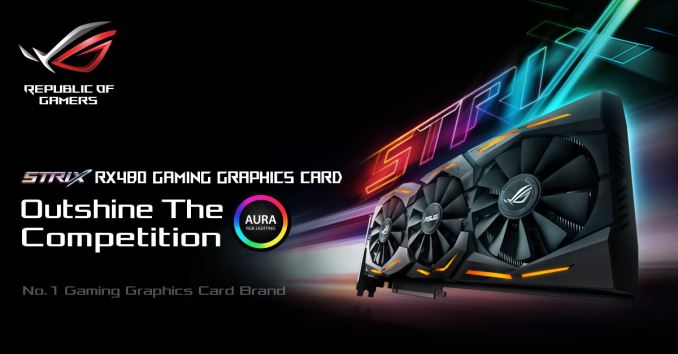

 Quote
Quote



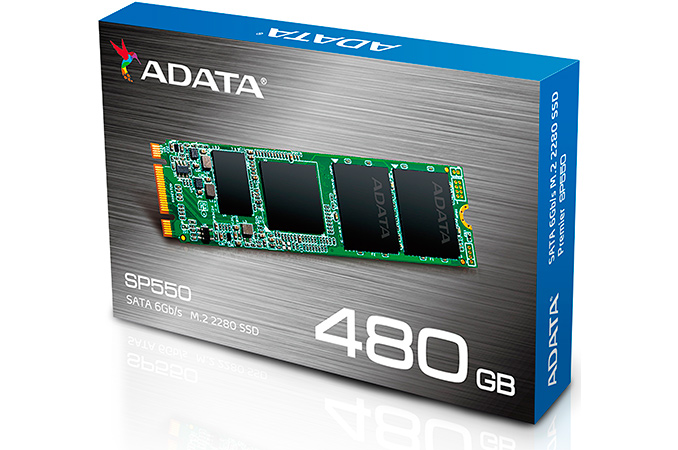


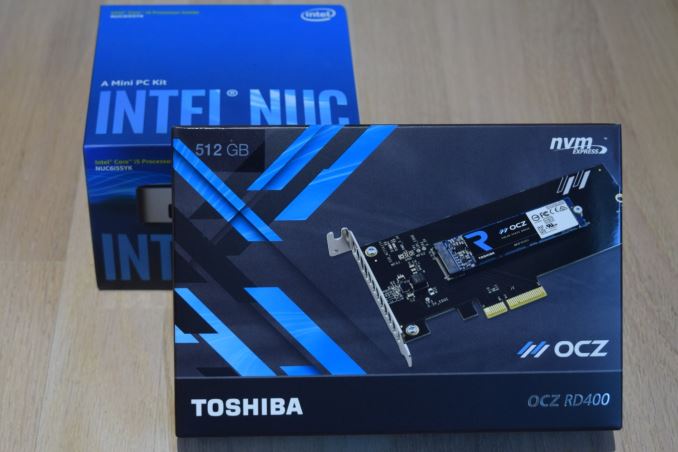









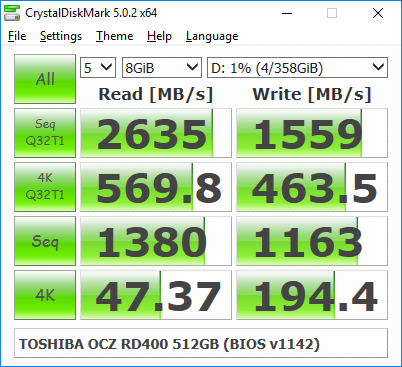
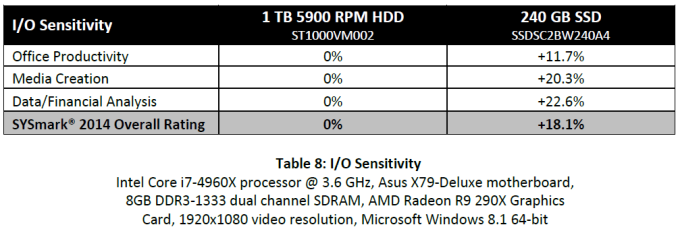



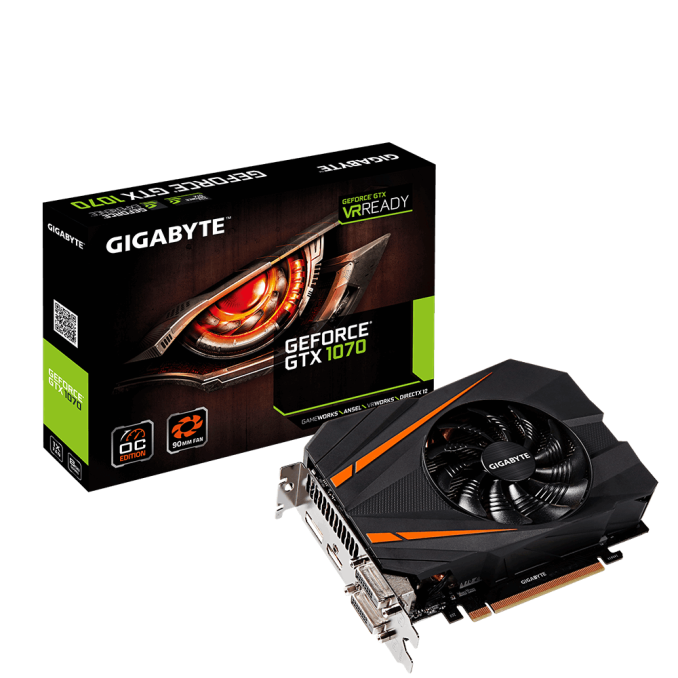
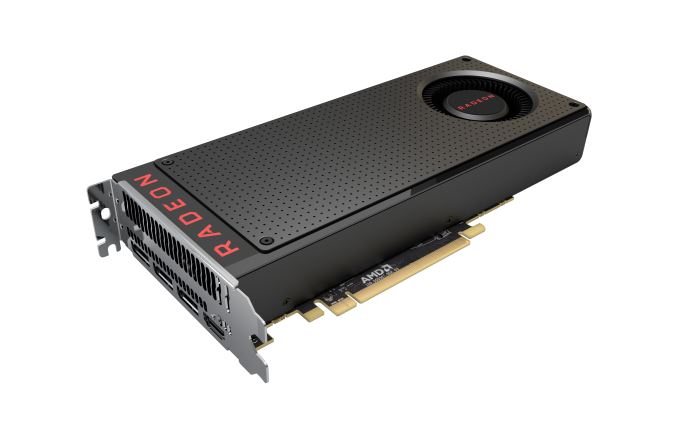
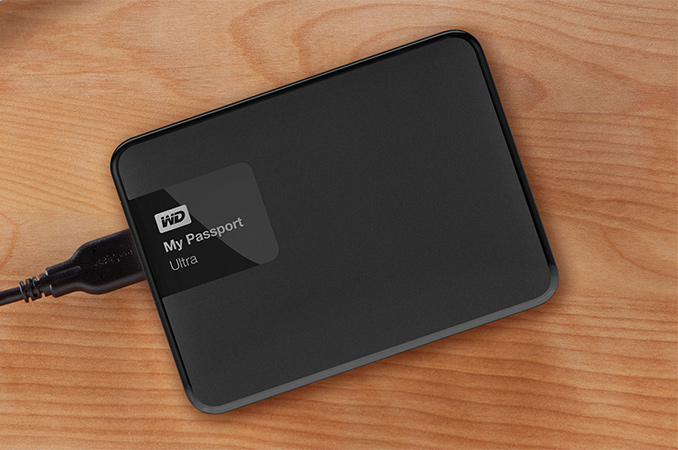


















Bookmarks